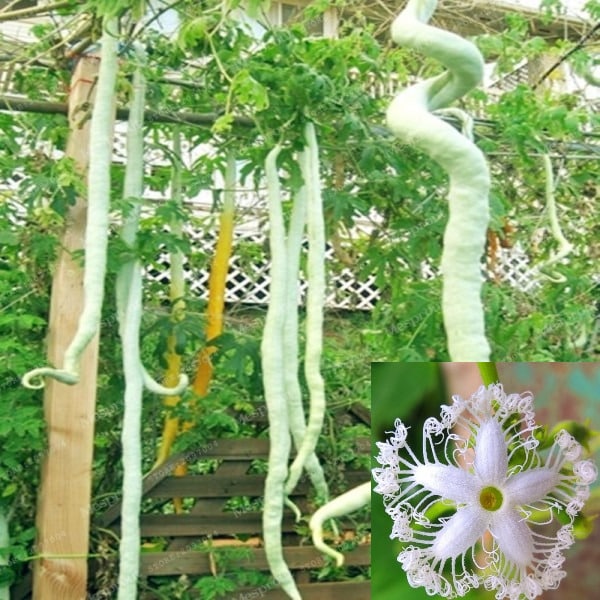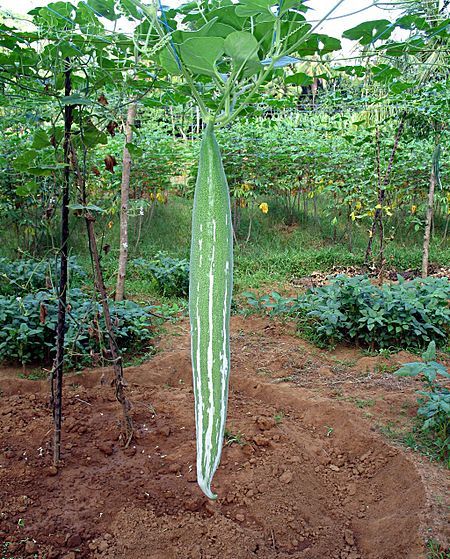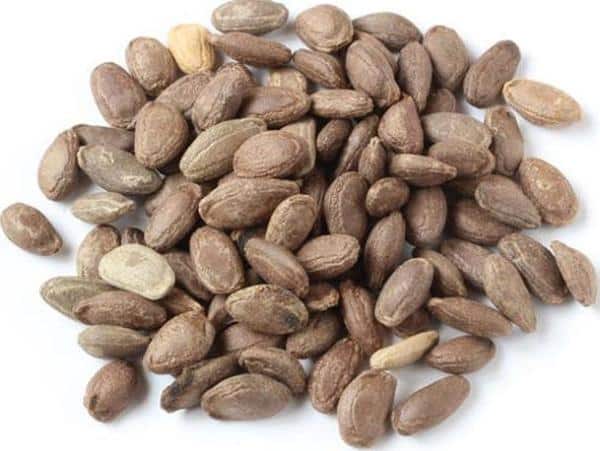Introduction to Growing Snake Gourds:
The following content is all about “Growing Snake Gourds” and it’s cultivation practices.
The snake gourd is also known as serpent gourd. The snake gourd also belongs to the Cucurbitaceae family. The snake gourd is native to South Africa, Australia and it is also grown in tropical parts of Africa. It is a vegetable which has an odd structure. The mature roots of this crop are used as soap. The leaves and shoots of the plant are also edible. The pulp of the snake gourd when extremely matured, sometimes tastes like tomato pulp. It is an annual plant with diverging tendrils. The leaves are either kidney or heart shaped. Snake gourd is a tropical or subtropical vine plant.
Asian countries consume it as a vegetable, but some parts of the world eat it when ripe (fruit form). The common names of snake gourd are padwal, chichinda, serpent gourd and snake gourd. It is mostly found in countries like Southeast Asia, India, Bangladesh, Nepal, Sri Lanka, Indonesia, Malaysia, Pakistan, Myanmar and China. For this crop’s better yield good cultivation techniques must be implemented and proper nutrition is to be supplied. The export of this crop produces highly profitable returns.
Characteristics of snake gourds:
- Snake gourds are well grown in tropical countries.
- The snake gourds are white and greenish in colour.
- The length of a snake gourd is 100 -150 cms and diameter is 65-70 cm.
- These are known as Chinese Cucumber. The exterior skin of the snake gourd is waxy, stripped with light greenish white shade.
- The snake gourd contains ovoid, flat and soft seeds.
- The seeds become hard and large when the vegetable reaches the ripening stage.
- When the vegetable ripens, it tastes bitter.
Properties of snake gourds:

- It doesn’t contain any fat.
- It contains carbohydrates, proteins and soluble fibre.
- Minerals found in snake gourd are Vitamin A and Vitamin E.
- Snake gourds contain 95% water content.
- The vegetable also has Calcium, Iron and Phosphorous.
Varieties of snake gourds:
Mansushri Kaumudi:
- It is a high yielding variety.
- They can be cultivated in acidic soils.
- These are white in colour.
- The average length of the snake gourd is 1 m.
- The average yield of this variety is 50 tonnes per hectare in 25 – 30 days.
APAU Swetha:
- This variety gives average yield.
- The colour of this variety is greenish white.
- The average yield of this variety is 12.5 – 15 tonnes per hectare in 28-30 days.
Baby:
- These varieties are smaller in size.
- They are white in colour.
- This variety is medium in length.
- The diameter of the snake gourd is 22 cm and length is 30-40 cm.
- The average yield of this variety is 25-30 tonnes per hectare.
Konkam Sweta:
- The fruit is medium in size.
- There length is 90-100 cm.
- They are white in colour.
- The average yield of this variety is 15-20 tonnes per hectare in 120-130 days.
Soil and climatic requirements for Growing Snake Gourds:

The soil suitable for cultivating snake gourds is sandy, loamy soil with a pH value of 6.0 -7.5. The soil should not be more basic or acidic in nature. The soil should be rich in organic matter and should be well-drained. For cultivating snake gourds too light or heavy soils must not be used. Aeration of the soil is a must for good growth in snake gourds.
These are well cultivated in tropical and temperate climates. These can be grown in warm and cold seasons and adjust to any climatic conditions. The plants can’t bear any extreme climatic conditions otherwise the yield and fruit quality is affected. The farm should be taken care, such that extreme frost and drought conditions do not harm it. During the growing period of snake gourds, bright weather is most preferable.
Land preparation and planting for Growing Snake Gourds:
For cultivating the snake gourd the land preparation must be done carefully. The soil should be ploughed several times. After the ploughings, to make the soil fine, levelling or harrowing should be done. In the field proper drainage channels should be arranged so that water which is excess can be drained out. The soil should be mixed with decomposed farmyard manure after ploughing. Each plant should be spaced 2.5 x 2 m apart. The approximate seed rate per hectare of the land is 3.0 -4.0 kgs.
Propagation method for Growing Snake Gourds:
The seeds can be planted directly into the fields. They can also be transplanted from the nurseries to the main field. Seeds are sown with a mixture of sand and fertilizer for germination. They are grown in protected conditions after the germination process. When seedlings start producing leaves, then they are transplanted to the main field. Pits of dimensions 30 x 30 x 30 cm are dug and left exposed to sunlight for some days. The pits must be filled with the manure and top soil. In the soil the seeds must not be sown deep; otherwise they will not germinate properly. After sowing the seeds, light irrigation must be given to the soil. The seeds are sown in the month of July or January.

Manure and fertilizer requirements for Growing Snake Gourds:
The natural organic matter can be used as manure. The natural organic matter that is farmyard manure can be used @ 10 kg along with 100 g of neem cake.. The mixture of Nitrogen: Phosphorous: Potassium @ 6:12:12 is used as basal dose per plant. The plant should also be fertilized with 10 g Nitrogen for 30 days after the sowing the seeds. The Azospiririllum and Phosphobateria @ 2 kg per hectare should be applied to the crops.
Irrigation methods for Growing Snake Gourds:
At least for 3-4 days, irrigation must be done during the initial stages of growth. Irrigation must be done on alternate days while flowering or fruiting. The ideal method of irrigation is furrow irrigation. The trickle or drip irrigation can also be used when there is limited water available. Drainage is essential for the plant survival and growth during the rainy season.
Flowering and pollination in Growing Snake Gourds:
For setting the fruits, pollination has to take place. The insects must carry out this process for setting in good yield of snake gourds. During rainy season, pollination process may become problematic as the bees become less active.
Intercultural activities for Growing Snake Gourds:
Pruning: The lateral branches should be removed from young plants so as to improve the yield. To facilitate early crop the tip of the main runner should also be removed. In a plant female flowers occur in between the 10th and 40th nodes, which should not be removed.
Pest and disease control methods for Growing Snake Gourds:
The pest like Leaf beetles and Leaf caterpillars can be controlled by spraying 50% of Trichlorofon 1.0 ml/ 1 litre of water or 76% of Dichlorvos 6.5 ml/ 10 litres of water.
The diseases powdery mildew is controlled by using Dinocap 1 ml / 1 liter of water and spraying on the plants.
The diseases downy mildew is controlled using a spray of Chlorothalonil 2 g/ 1 litre in 10 days interval.
Harvesting techniques for Growing Snake Gourds:
The snake gourds will be set for picking within 12-20 days from setting fruit. The length of the snake gourd is 30-60 cm when they are harvested. After sowing the snake gourds will be ready for harvest within 2-3 months. A sharp knife or scissors is used to cut the fruit stalk. These snake gourds are used in soups in Nigerian countries. The harvest time in snake gourds is indicated by the change in the colour of snake gourd from green to orange red colour. One single plant can produce 8-10 harvests. Care should be taken that the fruit doesn’t remain too long on the vine otherwise it becomes spongy, sour and splits open.
Post harvesting techniques for Growing Snake Gourds:
The snake gourd should be stored in temperatures between12-15˚C; temperatures below 10˚C can cause chilling injury to the fruit. They can also be stored in refrigerator so that they remain fresh for 10-14 days. The humidity for storing the vegetable should be maintained at 85-90%.
Yield of Snake Gourds:
The average yield of the snake gourd is 18 tonnes per hectare in 135-145 days. However, The yield varies from variety to variety. Apart from this, soil type, irrigation , season also affect the Snake gourd yield.
Read: BOTTLE GOURD CULTIVATION.
Read: GROWING CELERY IN CONTAINERS.

Detailed information for cultivation of snake gourd